Technology advancements and a growing demand for user-centric, energy-efficient spaces are driving a rapid transformation in the commercial lighting design industry. Smart lighting and the Internet of Things (IoT) have emerged as powerful tools for design professionals, enabling the creation of highly responsive, adaptable, and sustainable environments. Here we will delve into the potential of smart lighting technologies, their applications in commercial spaces, and the challenges and opportunities they present for design professionals.
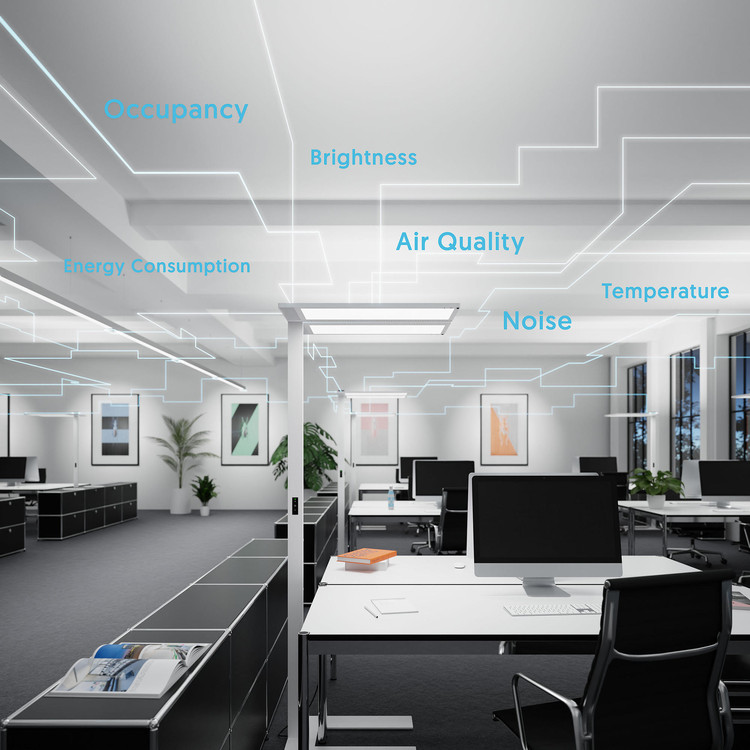 Image: IoT sensors can provide critical information used to optimize everything from smart lighting to air flow.
Image: IoT sensors can provide critical information used to optimize everything from smart lighting to air flow.
Understanding Smart Lighting and the Internet of Things (IoT)
Smart lighting refers to lighting systems that can be remotely controlled, monitored, and programmed using connected devices, sensors, and software. On the other hand, The Internet of Things, or IoT for short, is a network of interconnected devices, appliances, and systems that communicate and exchange data with each other. When integrated into commercial lighting design, smart lighting and IoT can offer unparalleled levels of control, flexibility, and energy efficiency, allowing designers more creative and functional control than ever before.
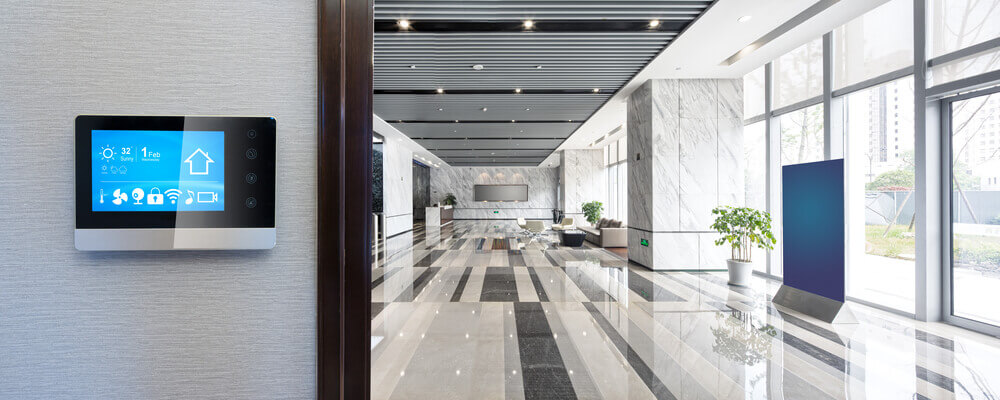 Image: Smart lighting is just one of the many types of building management devices in a connected commercial property.
Image: Smart lighting is just one of the many types of building management devices in a connected commercial property.
Benefits of Smart Lighting in Commercial Spaces
Smart lighting offers property managers unparalleled control over visitor experiences and maintenance costs. When properly integrated, smart lighting and IoT devices can help improve energy efficiency, create unique visitor experiences, increase visitor safety, and streamline the management of property resources. Let’s take a closer look at some of the benefits of incorporating a connected lighting system into your property.
Energy efficiency: Smart lighting systems can optimize energy consumption by adjusting light levels based on factors like occupancy, daylight availability, and space usage patterns. This results in reduced energy costs and contributes to the overall sustainability of commercial spaces.
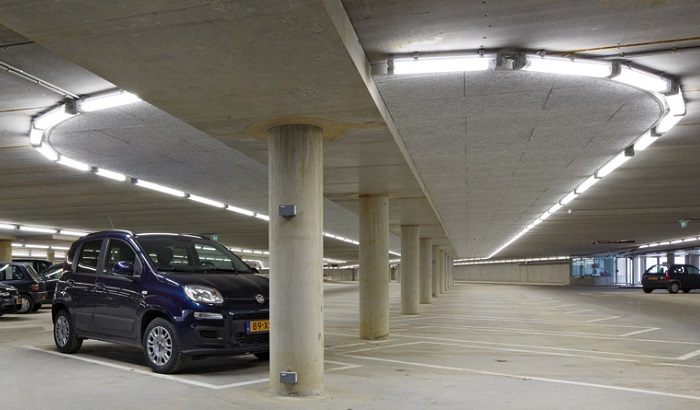 Image: Lighting control systems in parking garages can now include occupancy sensors, motion activated illumination and ground based navigation lighting.
Image: Lighting control systems in parking garages can now include occupancy sensors, motion activated illumination and ground based navigation lighting.
One case study from BridgeThings highlights the use of smart lighting in a commercial office parking lot. In this scenario, the smart lighting system identifies unoccupied spaces and dims the lights to a preset lower wattage. This ensures energy is not wasted while the spaces remain lit. By dimming lights in unoccupied spaces for an average of 16 hours per day, the company was able to reduce the energy cost per light per year by over 50%.
User comfort and well-being: By automatically adapting to the preferences and needs of users, smart lighting systems can create a more comfortable and pleasant environment in commercial spaces. This can lead to increased productivity, enhanced well-being, and improved user satisfaction. In large common spaces, a connected lighting system can be used to change the look and feel of your space based on seasonal or company events. While IoT sensors can be used to adjust color temperature and brightness depending on the time of year and hour of the day.
Image: Retail store managers can benefit smart lighting to have granular control over atmosphere while store owners can centrally administer and monitor large groups of stores.
Silicon Labs shares that smart lighting can enable the creation of modern retail experiences in commercial spaces. This is achieved through IoT wireless solutions, which help businesses attract and engage shoppers. For example, wireless technology can be used to facilitate the setup and maintenance of lighting via smartphone applications, enabling commercial spaces to adjust lighting conditions seamlessly and autonomously based on occupancy and daylight sensors.
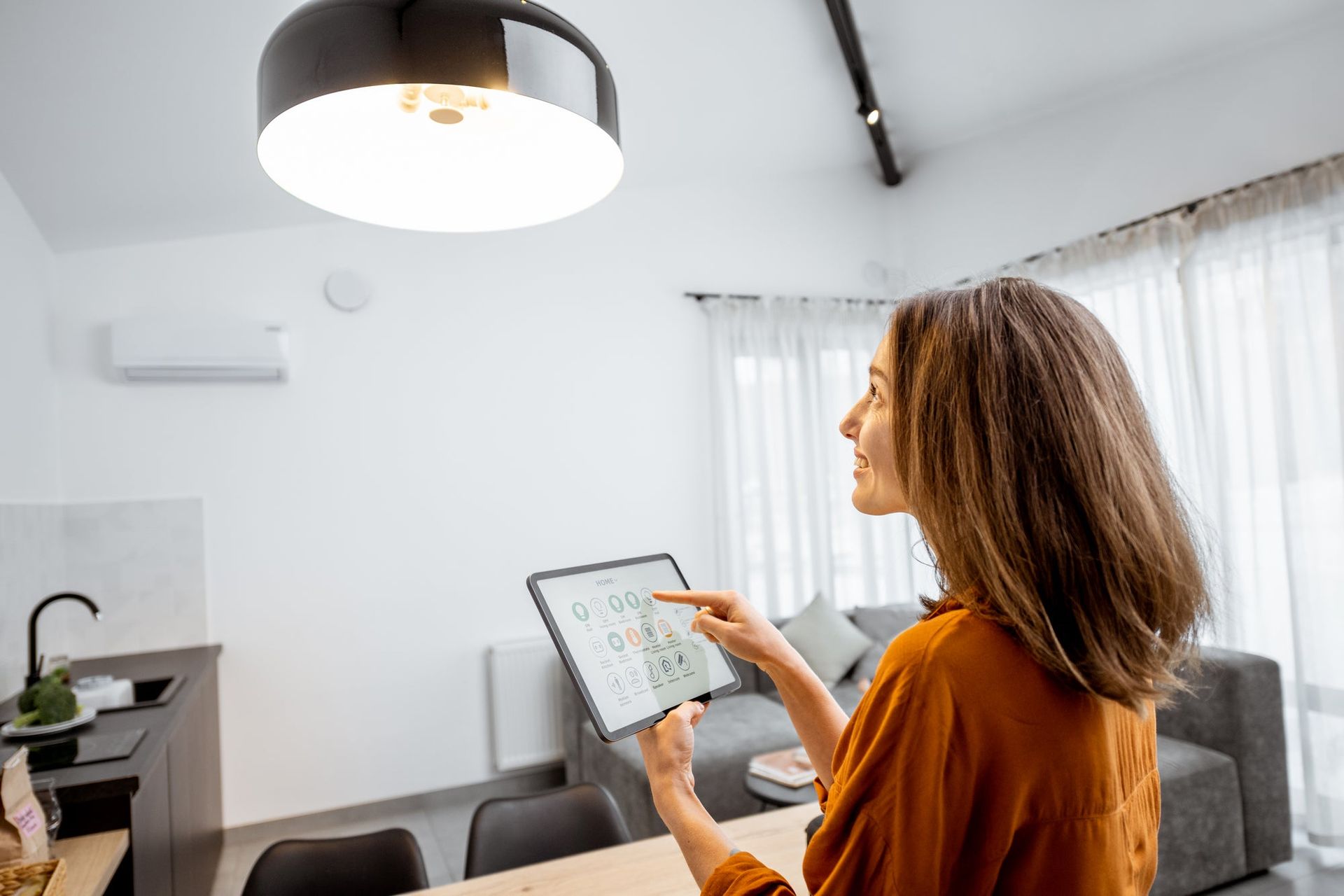 Image: Smart lighting offers incredible personalization options. From human centric lighting linked to your circadian rhythm to routines that change lighting atmosphere by time of day, by combining IoT devices, sensors and lighting you can achieve personalization and control over your space.
Image: Smart lighting offers incredible personalization options. From human centric lighting linked to your circadian rhythm to routines that change lighting atmosphere by time of day, by combining IoT devices, sensors and lighting you can achieve personalization and control over your space.
Customization and personalization: Smart lighting and IoT devices can provide design professionals with the ability to create highly customizable and personalized lighting schemes. Users can easily adjust color temperature, brightness, and other lighting parameters to suit their specific requirements or preferences. With properly specified sensors and devices, the IoT can provide property owners with nearly limitless ambiance options for entertainment, events, retail, conferences, and everything in between. This flexibility takes planning and experience to effectively integrate into commercial spaces, make sure you are working with commercial lighting professionals to finalize your plans.
Maintenance: Smart lighting systems can alert facility managers to potential issues or the need for maintenance, ensuring that commercial spaces remain well-lit and safe at all times.
Remote monitoring: Connected devices can be monitored remotely for issues arising with hardware and software on the network. With mobile apps and custom software, property managers can be instantly alerted to any issues, whether onsite or offsite. This allows for centralized management of lighting systems and easier repair and maintenance, lowering the total cost of ownership and improving the management experience.
Challenges and Considerations
While the benefits of implementing a smart lighting strategy should be clear, there are numerous factors to consider when considering adding smart lighting to your property. As with any new technology, there will be challenges in finding the right balance between cost, features, and maintenance. Finding the right balance for your specific project requirements will be critical to the success of your smart lighting implementation. Let’s take a look at some of the most common challenges and explore how to overcome them.
Integration and interoperability: With a wide variety of smart lighting systems and IoT devices available on the market, design professionals must ensure seamless integration and interoperability between different components and platforms. As hardware and software continue to evolve at an unprecedented rate, the ability to easily connect and manage different devices is essential for creating a truly smart building.
There are a number of different ways to achieve integration and interoperability. One common approach is to use a central hub or controller that can connect to and control multiple devices. This can be a good option for larger systems with a variety of different devices. Another option is to use open standards that allow devices from different manufacturers to communicate with each other. This can be a more flexible option, but it can also be more complex to set up.
Security and privacy: As with any connected system, smart lighting and IoT technologies can be vulnerable to security breaches and privacy concerns. Design professionals must prioritize robust security measures and data protection protocols to safeguard against potential threats. When implementing a connected system, your IT professionals must be able to safeguard it from internal and external threats. If your firm is responsible for the integration, consider asking your insurance underwriter if you are properly covered.
Wireless SoC solutions (System on a Chip) from companies such as Silicon Labs offers all major mesh networking technologies - including Bluetooth mesh, Zigbee, Thread, and Z-wave - which are suited for the unique requirements of lighting. Mesh networking allows for large-scale, multi-hop communication and supports mains and low-power nodes. This allows for the optimization of core devices in a mesh network for relay messages between nodes, and for the design of low power IoT devices for specific lighting functions such as sensors, light switches, and dimmers. This maximizes IoT security in commercial lighting applications, which is paramount as vulnerabilities can threaten the entire network, business applications, and public security
Cost and complexity: Implementing smart lighting systems can involve higher upfront costs and greater complexity compared to traditional lighting solutions. You will need experienced professionals through the design, implementation, and management phases. However, the long-term benefits in terms of energy savings, user comfort, and reduced maintenance often outweigh these initial challenges. Whether you are a small hotel or a sporting arena, a connected lighting system ensures your guests a modern experience and streamlines property management.
Upgrades and maintenance: Significant attention should be paid to the upgrade processes for hardware and software. Many companies rush to market with flashy new technology, only to leave property managers with headaches as companies discontinue products or go out of business. Consider how often you will be committed to upgrading your lighting hardware, depending on your resources and budget. Work with seasoned IT pros who can advise on manufacturer and product depreciation schedules as well as replacements. Property managers should subscribe to vendor and rep news to stay up-to-date with the latest changes.
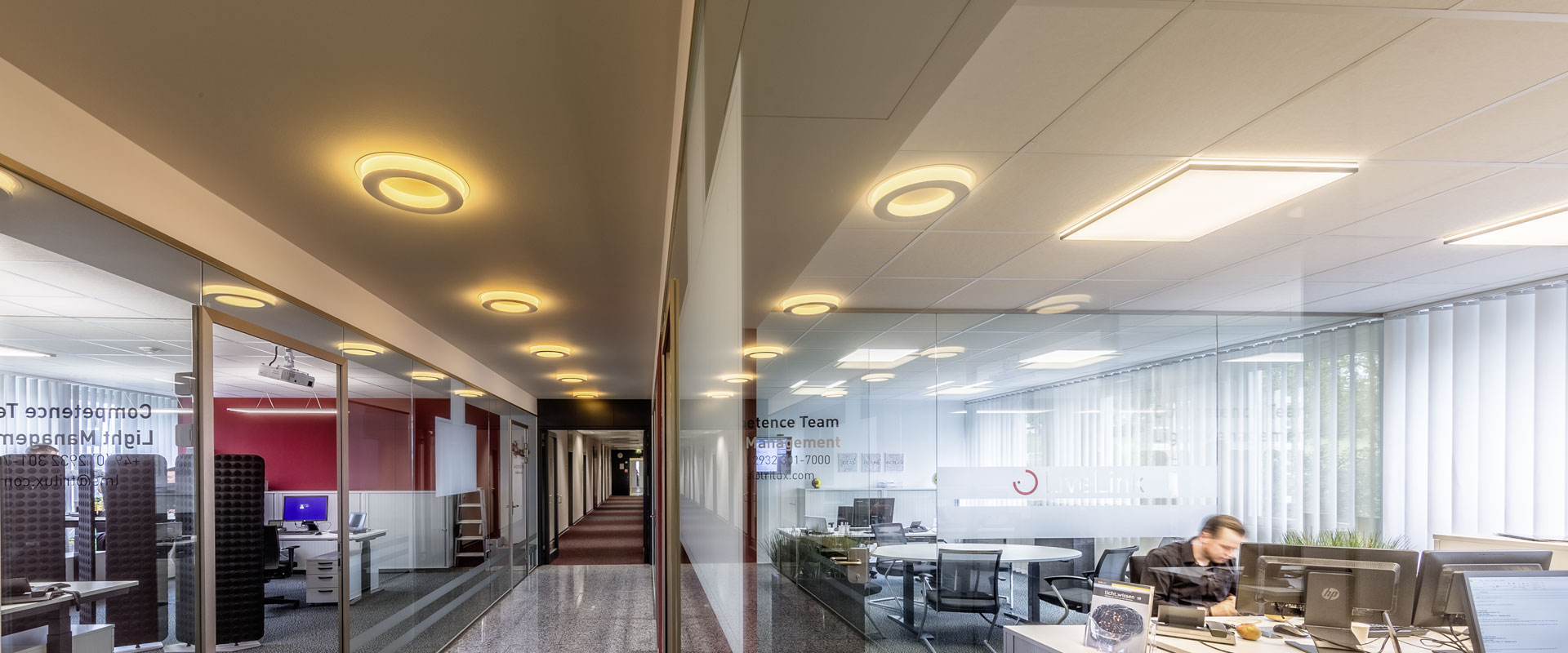
Future Trends and Opportunities
Technology and society along with it have been moving at an unrelenting rate. Advances in manufacturing technology have meant that devices are getting smaller and more powerful faster than ever before. While advances in artificial intelligence are changing the way we live, work, connect, and play on an almost daily basis. The future for connected commercial spaces may be bright, but there are a few trends that shine through.
Human-centric lighting: As the focus on user well-being continues to grow, smart lighting systems can be further refined to support circadian rhythms, enhance productivity, and promote overall health and wellness in commercial spaces.
Advanced sensors and data analytics: The integration of advanced sensors and data analytics capabilities can provide design professionals with deeper insights into space utilization and user behavior, enabling the creation of more responsive and intelligent lighting environments.
Integration with building management systems: By integrating smart lighting with other building systems like HVAC, security, and access control, design professionals can create truly holistic, interconnected spaces that optimize efficiency, sustainability, and the user experience.
Smart lighting and IoT technologies have the potential to revolutionize commercial lighting design, offering unparalleled opportunities for energy efficiency, user comfort, and customization. By understanding and embracing these innovative tools, design professionals can create dynamic, intelligent, and sustainable commercial spaces that meet the evolving needs and expectations of the modern world.

